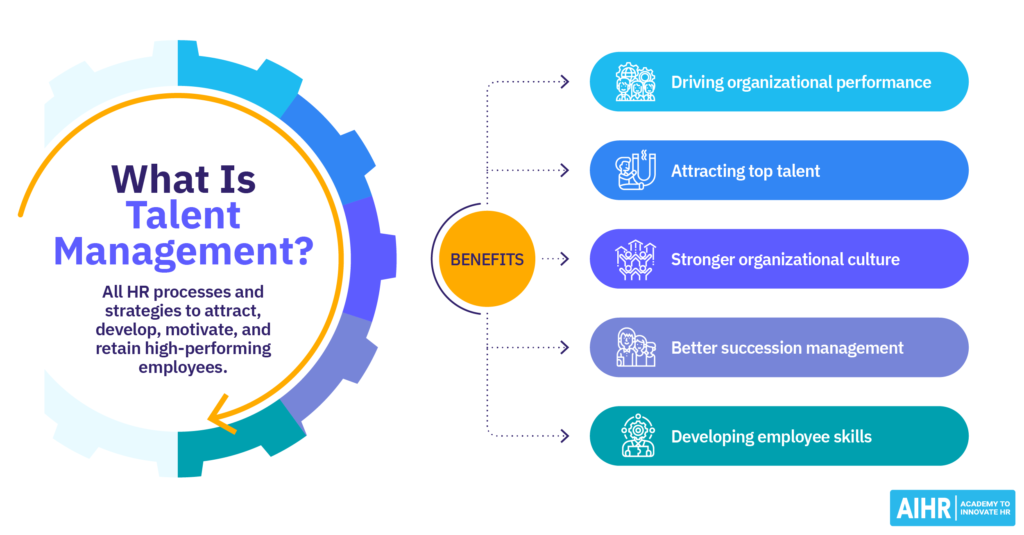Organizations that put people first are the ones that stay ahead of the game. When it pays attention to the manner it attracts, retains and develops its employees (referred to as “human capital” or “talent”) it gives the organization an edge over its competitors.
In order for firms to evaluate their present workforce demands and create plans for future employment requirements, talent management is a strategic process that involves meticulous workforce planning.
However, the answers to your questions on what talent management is and if it is necessary for an organization’s success are given below.
Understanding Talent Management
To explain talent management simply, it is investing in the organization’s most essential commodity, its people. For an organization to accomplish this task, it must recruit candidates with in-demand skill sets, provide continuous learning and development.
A 2018 McKinsey survey found that 99% of participants who rated their company’s talent management as highly effective also reported outperforming their competitors, compared to 56% of participants without effective talent management systems.
Talent management’s long term impact is attributed to sound talent attraction and retention strategies, which contribute to a sustainable competitive edge.
A practical example of talent management is given below:
Large tech companies sometimes find difficulty in diversifying, especially with launching new products or shifting their focus from selling software licenses to offering comprehensive cloud-based solutions. To accomplish this, the company must identify employees proficient in cloud technologies, customer services and data analysis.
To build this powerful workforce, businesses require talent assessment tools, like Zenithr’s psychometric or competency based assessment that helps the business identify the right candidates with the right skills.
Zenithr utilizes Thomas International’s psychometric and competency testing. As a registered member of the British Psychological Society, Thomas International develops assessment program to assist managers with:
- Improving hiring accuracy
- Talent mobility
- Onboarding
Additionally, for the organization to build its power workforce, it should put performance analytics systems into place. These systems provide managers with actionable insights, thus enabling them to effectively work with their teams in achieving the organization’s vision.
Key Practices for Effective Talent Management
There are five key areas marked for effective talent management are as follows:
- Talent Acquisition
The initial stage of talent management involves vigilant workforce planning. It takes into account employees’ key competencies, skills and capabilities the organization requires to fulfill its various roles, aligning those with short term forecasting and predictive planning.
It includes attracting and acquiring talent through internal or external candidates or outside portals.
- Performance Management
The second phase of talent management involves developing employees’ goals and expectations, building support structures, performance evaluation, avenues for feedback, addressing and rewarding performance outcomes.
- Employee Onboarding
The onboarding procedure used by a company is crucial for drawing in and keeping top personnel as well as guaranteeing a positive work environment. According to research, about 40% of workers quit their jobs within the first three months of starting work because they had a bad experience.
Zenithr’s Employee Onboarding tool provides support and value to employees with strong surveys to retain talent and create fulfilling work experience.
- Learning and Development
Learning, or training and development is a joint venture between employees and the business. Traditionally, businesses saw training and development as the employee’s responsibility. However, business and employees now work together to up-skill or reskill employees’ existing skill set or to fulfill new roles.
Focusing on building skills, especially soft skills like empathy, leadership or adaptability helps the organization shorten the skills gap. Using Zenithr Competency Based Assessment will assist organizations identify and build soft and hard skills.
- Improve transparency and trust
Receiving feedback from team leaders or supervisors empower employees to build their strengths thus reducing employee turnover and increasing engagement. This encourages employees to meet the organization’s key goals.
- Compensation and Rewards
Employers taking a holistic view of compensation and rewards improves their employee experience. This ensures the organization’s perks and benefits go beyond the monthly paycheck.
Employees enjoy a little extra from their employer, it may not always be monetary. Satisfied employees seek validation for work completed. Compensation and reward can come in the form of paid vacation, healthcare, dental coverage and retirement plans like 401(k) contributions.
- Employee Engagement and Retention
Employee engagement and retention are influenced by job satisfaction and the efficacy of talent management techniques.
Retention is the ability of an organization to keep top personnel, especially high performers, from looking for other possibilities, whereas engagement is the emotional commitment that employees have to their work and the organization.
Zenithr’s Elevate is the ideal tool for lasting impact throughout the organization. It is a smart online automated system allowing employers to efficiently analyze employee data, thus reducing employee turnover and improving employee engagement.
Talent Management Strategy
An effective talent management strategy fully supports and boosts an organization’s goals and vision. Assessing workforce dynamics and foreseeing potential difficulties with a variety of strategic tools, such as those listed below, are essential components of effective people management.
- To match workforce planning with corporate objectives, a SWOT analysis of talent assessment considers external opportunities and threats in addition to internal strengths and weaknesses.
- Organizations can anticipate possible future events, evaluate their effects, and create crisis response plans with the aid of scenario planning.
- Industry scans and environmental scans look at more comprehensive evaluations that look at economic, social, political, and technological aspects that affect long-term success. It looks at trends and disruptions within the organization’s sector and the impact thereof.
- Senior leader interviews refine the organization’s strategic objectives. Employees need regular updates and feedback from those seniors. It gives them a sense of value to the business.
- Employee Interviews and Surveys determine employee experience initiatives. They identify performance gaps and development needs.
Zenithr Experience gives employees a voice. It adds value to employee’s voice by analyzing their thoughts and feedback which improves top talent retention, encouraging new talent acquisition.
Conclusion
Talent Management is an essential tool organizations can use to attract, develop and retain employees. With strategic talent management systems and viable business solutions like those offered by Zenithr, businesses build a powerful workforce that drives long-term success.
By harnessing tools like Zenithr talent assessment and psychometric assessment, businesses can identify candidates with the right skills set and cultural fit.




